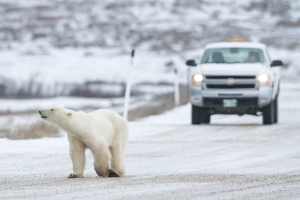Black bears are common within Canadian forests. If you ever encounter one, the best way to scare it away is by making yourself look as big as possible or by making loud noises using pots and pans or an airhorn.
Fast Facts
Common name: Black bear
Scientific name: Ursus americanus
Type: Mammal
Diet: Omnivore
Group name: Sleuth or sloth
Average weight: 115 to 270 kilograms (males); 92 to 140 kilograms (females)
Average length: 1.5 metres to 1.8 metres
COSEWIC Status: Not at risk
Did you know?
A subspecies of black bear that lives in British Columbia’s Great Bear Rainforest has a creamy white coat because of a recessive gene. These bears are called Kermode or spirit bears.
Physical characteristics and behaviour
The black bear is the smallest and most widely distributed bear species in North America, found in every province and territory in Canada except Prince Edward Island. Although they are called black bears, their coat can be brown, dark red or blueish, and a subspecies of the black bear that lives in British Columbia’s Great Bear Rainforest even has creamy white fur (these are called kermode bears, or spirit bears). Black bears have rounded ears and small eyes. Their tail is very short and almost unnoticeable.
Black bears have five curved claws on each foot. These are very strong and are used for digging up roots, stumps and old logs when searching for food. These bears may be large, but they’re also fast, and able to run at a top speed of 45 kilometres per hour!
As the weather turns colder, black bears put on weight in preparation to sleep away the winter. During hibernation, their body temperature drops slightly, and their breathing and heart rate slow down, allowing them to live off their stored body fat without having to forage for food. Females give birth to one to three cubs in February, and stay in their dens until the cubs’ eyes are open and they have put on enough weight to be able to follow their mothers in search of food.
Diet
Black bears are omnivorous. In the wilderness, they eat berries, vegetation, insects, fish, small mammals and birds, depending on what is available. But in areas near human settlements, where their preferred food is scarce, bears have been known to eat garbage, grain crops and even domestic livestock.
Habitat and distribution
Black bears are found in every province and territory in Canada except Prince Edward Island. They primarily live in forests, but are also found in mountains and swampy areas.





